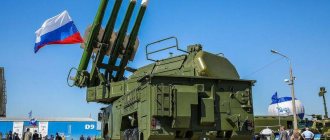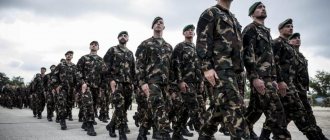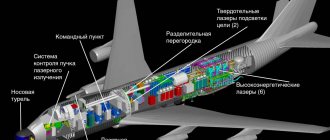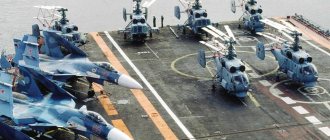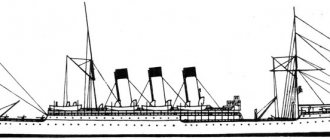“Made with us” and on Yandex.Zen
Dear friends, our Air Force is currently undergoing active modernization, the most modern aircraft and helicopters are being commissioned, and information about these achievements of our country is regularly published on our website. It is also known that there are a number of whining hamsters who are eager to whine for any reason and for no reason. Their whining sounds like: oh, how Russia is behind the progressive West.
As you know, everything is learned by comparison. In this review we will look at the current state of the German Air Force - the Luftwaffe. So, what is Germany capable of producing and what is it armed with?
Luftwaffe composition:
1. Bomber aircraft.
Zero. Neither long-range, nor medium-range, nor short-range, nor subsonic, nor supersonic...
2. Attack aircraft.
Zero.
3. Fighter aircraft.
HERE - you’re just left in a precipitate, but it’s a FACT that one of the main fighters of the Luftwaffe is... a veteran of the Vietnam War, the F-4 Phantom. FACT - 45 aircraft in service. The Phantom made its first flight in 1958 and was discontinued in 1981:
There are also 55 Typhoon Eurofighters developed in the 1980s:
All.
4. “Hindering” aviation. In Russia there is no such term - interdiction - it means aviation that interferes with the enemy with its actions in places where there is no front: shooting enemy military columns, setting up radio interference, that type.
This aviation is represented in the Luftwaffe by two variants of the Panavia Tornado aircraft: 32 radio jamming aircraft and 145 ground attack aircraft. Aircraft developed in the 1960s, discontinued in 1998:
The “successes” of this aircraft are evidenced by the experience of their use in 1991 in Iraq, when Iraqi air defense was already suppressed. However, even with this level of enemy condition, Tornado's losses were 11%.
5. Transport aviation.
The Luftwaffe has 8 VIP aircraft for transporting generals (2 Airbus A-340 and 2 A-319, 4 Bombardier Global Express-5000), 4 A-310 tankers and 80 C-160 transport aircraft developed in the 1950s. (first flight - 1963), discontinued in 1985:
Speed - 513 km/h, flight range - 1,800 km, load capacity - 16 tons.
6. Training aviation.
Represented by two types of aircraft:
Beechcraft Texan II:
(the pilots train in the States, so I give them the US Air Force livery) and the Northrop T-38. Developments in the 1950s, first flight - 1959, discontinued in 1972:
7. Drones.
There are already three of them in service with the Luftwaffe. Israeli intelligence Heron.
8. Helicopters.
There are already 55 of them in service with the Luftwaffe, of which 54 are Bell UX-1 Iroquois. Developments of the 1950s, first flight - 1956:
The reader can answer the rhetorical question of what Germany itself produced from all this.
Materials used https://en.wikipedia.org/wiki/Luftwaffe#Aircraft_inventory and many others.
Modernization of the German Air Force
| German Air Force tactical fighter "Typhoon" |
In the context of a changed political situation in the world, the military-political leadership (MP) of Germany is rethinking the role and tasks of its armed forces. At the same time, the air force is of particular importance as the most effective and high-tech component of the armed forces.
Large-scale military reform in Germany, carried out from the early 2000s until 2012, did not fundamentally change the structure of the national air force. The number of air divisions was reduced from four to three, the transport air command was disbanded, and the number of combat and auxiliary squadrons was slightly reduced. In addition, the process of a real transition to new types of military equipment has begun, which is actively continuing to this day. The German Air Force quickly got rid of Soviet MiG-29 tactical fighters, transferring them to Poland for a symbolic 1 euro, and at the same time dismissing most of the not-so-bad pilots from the GDR military aviation.
Until 2012, the structure of the Air Force continued to be typical for any branch of the German armed forces. They were headed by an inspector (commander), whose working body was the main headquarters of the Air Force, which was part of the central apparatus of the German Ministry of Defense.
The organizational structure of the Air Force included two main blocks - the operational command (OC) of the Air Force and the central control (CC) of the Air Force (both located in Cologne-Van). At the same time, the OK included all aviation divisions and the operational command. The central department included training and support formations.
A turning point in the process of German military reform was the adoption in 2011 of a new military doctrine, called the “Main Directions of German Defense Policy.” The document interprets in a new way the tasks of the armed forces and each individual branch of the armed forces.
Thus, the main goal of the planned transformations in the German Air Force is to increase the combat capabilities of aviation and air defense forces while simultaneously reducing the number of formations and units that comprise them. The main attention is expected to be paid to improving the combat command and control system, reorganizing reconnaissance aviation, as well as equipping formations and units with modern aircraft.
Based on the “Basic Provisions of the German Defense Policy,” the range of key tasks of the German Air Force is expected to shift from gaining air supremacy and combating enemy aircraft to direct air support of troops, surveillance and aerial reconnaissance. At the same time, it is planned to maintain the necessary potential for conducting strategic air operations provided for by national or coalition plans.
According to the reform plans, the highest authority of the German air force becomes the General Command (GC) of the Air Force, headed by the inspector (commander-in-chief). The garrison of Berlin-Gatow (10 km south of Berlin) was chosen as the location of the Civil Command. It will develop general and long-term plans for the construction, combat training and operational use of the Air Force, as well as determine the deployment (basing) of its constituent formations and units.
The fundamental point is the fact that the main command of the Air Force, like the Civil Command of other types of armed forces, is removed from the structure of the central apparatus of the Ministry of Defense. It is no coincidence that the location of the main command of the Air Force was chosen - Berlin-Gatow. Thus, the Civil Code plans to restore the military traditions of the garrison, on the territory of which the largest air fleet museum in Germany is now located.
The long-term structure of the German Air Force's command and control bodies is divided into three main areas of activity - operational leadership, combat control and support. At the same time, the divisional level is completely excluded from the Air Force control system, and divisional headquarters are subject to reduction.
The task of operational leadership is planned to be entrusted to the command of the operational forces (COF) of the Air Force (Cologne-Van). It must bear direct responsibility for organizing combat training, developing plans for the combat use of units and formations, technical equipment and logistics support. Two components will be directly subordinate to the CBS - air and ground.
The air component will combine combat and transport aircraft. Combat aviation will include three (in the future, possibly four) tactical fighter aviation squadrons (AvB Wittmund, Nervenich, Neuburg and Laage), as well as fighter-bomber (AvB Büchel) and reconnaissance (AvB Yagel) aviation squadrons.
Transport aviation will be represented by transport aviation (AvB Wunsdorf) and transport helicopter (AvB Holzdorf) squadrons and a special transport air group (Berlin/Cologne-Wan).
Strategic reconnaissance UAV "Eurohawk" |
The basis of the ground component will be: a missile defense squadron (Husum), two control and communications regiments (Schönewald and Erndtenbrück), an air force facility security regiment (Shortens) and an information and technical support regiment. The component will also include German Air Force training centers in the USA and Italy (AvB Holloman and Decimomannu), as well as an electronic warfare center (Kleinantingen).
In the promising structure of the German Air Force, a special place is given to the 51st reconnaissance aviation squadron (AvB Jagel). It is expected to include the 511th reconnaissance squadron (RAE) and the 512th squadron of reconnaissance unmanned aerial vehicles. At the same time, the 511 rae will be equipped with Tornado RECCE reconnaissance aircraft and Tornado ECR electronic warfare aircraft.
The Air Force command associates the expansion of reconnaissance capabilities of aviation with the adoption of reconnaissance UAVs for strategic and operational purposes. In this regard, the Eurohawk reconnaissance UAV is expected to be included in the 512th Squadron by 2014. In the period until 2015, it is possible that four more similar devices will be put into service, and before 2017, the same number of Global Hawk UAVs intended for deployment of the AGS air reconnaissance system for ground targets.
Currently, the German Air Force is at the stage of making a decision to begin implementing a program to equip the national air force with medium-altitude attack UAVs for operational-tactical purposes. In accordance with plans, by 2022 the German Air Force should have 16 such UAVs in service with the 512th reconnaissance squadron.
The procurement program for medium-altitude UAVs is planned to be implemented in two stages. At the first stage, it is possible to purchase a batch of five units, which the Bundeswehr will use as a “transition model” for the period from 2015 to 2022. At the same time, samples from Israeli (Israel Aerospace Industries) and American (General Atomics Aeronautical Systems) companies are being studied.
At the second stage, it is planned to create a “European” attack unmanned aerial vehicle. The EADS concern is actively carrying out work in this direction.
The German Air Force's combat control tasks will be assigned to the Air Force's Main Operations Center (GOC) (Kalkar). The center must ensure German participation in the work of operational planning and control of forces and assets of the multinational air force group during the preparation and conduct of operations under the general leadership of NATO and the EU.
The GOC is planned to subordinate the following structures: the German headquarters component in the NATO Allied Forces (AvB Ramstein); the German component at the headquarters of the European Air Transport Command (Eindhoven, the Netherlands); the German component of the AWACS-NATO command and control aviation (Geilenkirchen); German component "AGS" (AvB Sigonella, Italy); German components in NATO and EU structures; Air Force Operations Center (Kalkar); National Center for Airspace Defense (Udem); space control center (Udem); information technology support group (Kalkar).
The Air Force Support Command (CSO) (Cologne-Wan) will be responsible for organizing the recruitment and training of personnel for the German Air Force, as well as for logistical and medical support for their activities. It will include: the German component of the NATO program center, the technical training center (Fasberg), the officer (Roth) and non-commissioned officer (Appen) schools of the Air Force, the training battalion of officer and non-commissioned officer candidates (Germersheim), the information technology group support, as well as the air traffic control department of the Bundeswehr (Frankfurt am Main), the air force medical service department (Cologne-Wan) and two air force weapons centers (Schonewalde and Manching).
The reform plans approved by the Bundeswehr command provide for the withdrawal of CH-53 medium transport helicopter units from the ground forces and their transfer to the Air Force helicopter transport squadron (AvB Laupheim and Holzdorf). All light transport helicopters NH-90 and fire support helicopters "Tiger", on the contrary, will be concentrated as part of the rapid reaction division of the German Army.
Military transport aircraft of the German Air Force C-160 Transall and A.400M |
As part of the Bundeswehr rearmament program in the Air Force, it is planned to completely replace outdated weapons and military equipment with new and modernized models within five years. Thus, the Luftwaffe is expected to have up to 225 combat aircraft (of which Typhoon - 140, Tornado - 85), about 100 transport aircraft (Transall - 60, A.400M - 40), 64 CH- 53, nine strategic and 16 operational-tactical UAVs, 112 Patriot missile launchers.
Assessing the tactical and technical characteristics of the new aircraft of the German Air Force, it should be noted that the Typhoon tactical fighter is a competitive aircraft on the world market and corresponds to the “4+” generation. At the same time, it is difficult to attribute it to a “breakthrough” in the world of aviation. The situation is even more complicated with the adoption of the A.400M transport aircraft. The manufacturer, represented by the Airbus Military consortium, is constantly delaying delivery dates. At the same time, the performance characteristics of the vehicles have undergone significant changes towards deterioration, which causes extreme dissatisfaction on the part of the Air Force command.
When analyzing the prospects for the development of the German Air Force, attention is drawn to the moral and psychological aspect of reform. Thus, this type of armed forces, more than any other, preserves the combat traditions of German aviation. For example, the names of the squadrons (71 AAESK - "Richthofen", 51 RAESK - "Immelman", 31 AAESK - "Belcke") were given to them in honor of the pilots of the First World War. A large number of biographies and descriptions of the military exploits of German aces during the Second World War are constantly published in special publications. The appearance of the characteristic silhouette of the Me 109 in the air is not surprising - in Germany there are a large number of clubs and societies where combat vehicles are carefully preserved and restored, thereby maintaining the interest of young people in aviation.
Another feature of the German Air Force is the extreme “Americanization” of military pilots. This is explained by the fact that pilot training takes place in the USA using American methods and aviation equipment. At the same time, units of the national air force participate in a large number of large-scale combat training events in the United States together with their American colleagues.
Thus, the military reform carried out by the German leadership is designed to ensure the further priority development of the air force. At the same time, the Air Force control system is being improved and, despite economic difficulties, active steps are being taken to technically re-equip this type of armed forces.
(Colonel A. Lopukhov, “Foreign Military Review”)
